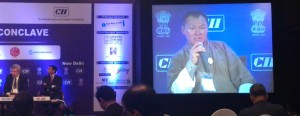Technology and opportunities in Bhutan highlighted at New Delhi summit
View(s):NEW DELHI – A small landlocked country in the north of South Asia, at the foot of the Himalayas, Bhutan sits between two economic giants, India and China, with its goods having to cross the borders of these two countries for any sort of international trade to happen.
Bhutan was also famously the last country in the world to adopt television, in 1998.However, thanks to its abundant hydropower generation capacity, which it has now started exporting, the country has taken some of the biggest technological leaps in the South Asia region in recent times.

Karma Dhendup making the presentation
This included the 2014 cooperation between the government of Bhutan and Japan’s Nissan to roll out the Nissan Leaf, a part of the plan to become even more environmentally-friendly while weaning itself off of fossil fuels in favour of electricity, of which there is a plentiful supply. It also has strong conservation credentials, with a long-term plan to maintain its current 60 per cent forest cover by focusing on renewable and sustainable energy and related best practices.
In an interview with the Business Times, during the first-ever South Asia Economic Conclave, held this week in New Delhi, IT entrepreneur Karma Dhendup, a senior member of his country’s chamber of commerce and the Managing Director of Athang ICT Tech, a provider of software, training and animation, spoke about the growth of technology-related sectors in Bhutan and its future in these areas.
Starting off, Mr. Dhendup noted that Bhutan not only opened up to television in 1998 but this was also the year that the country, a monarchy, was first exposed to the Internet. He further indicated that, at the time, costs were prohibitive, with US$ 15,000 being not uncommon for a connection, but now it is more reasonable while still a little high in cost because of the country’s extensive dependence on India for the service as well as a lack of economies of scale to drive costs down, with Bhutan only having approximately 750,000 people. He also revealed that around 200 of Bhutan’s 205 sub-districts were connected by fibre optics, so Bhutan was now pushing these communities to capitalise from Internet, as well as even mobile phone, connectivity.
Commented Mr. Dhendup, “If you look at the IT activities happening in Bhutan, Bhutan is very active in Business Process Outsourcing (BPO). We do have a few companies set up which have 200 or more people. We’re very culturally rich, artistic people that are in born with every Bhutanese, that makes Bhutanese very good artists, so one of the BPO industries that functions successfully in Bhutan is on this, art design and graphics and all that, and also a few American companies have set up there”. He also added that there was a big push for e-commerce in Bhutan because, since it imports more than it exports, the government was keen on any industry bringing in foreign exchange, and as such was trying to accelerate these by providing them loans, etc. E-commerce was one of the industries being encouraged. However, he said that, since industrialisation is actually low in Bhutan, the products sent out to the world are typically handicrafts and even organic agricultural products such as apples, oranges and even mushroom, but the shelf lives were very low and the agricultural products had to be sent by airfreight. He further cited the examples of Bhutanese Red Rice, now available on Amazon, at US$ 41 for 500 grammes, as well as Matsutake mushrooms from the country that were highly sought after in Japan despite their high cost.
Mr. Dhendup also signalled, “From Bhutan’s perspective, it exports a lot of hydroelectricity while fossil fuels are burned at home. Bhutan pays Indian Rs. 8 billion for fuel, if we convert our automotive transportation systems to electric systems, our government’s view is that we can cut this Rs. 8 billion down and we can actually help the country’s economy. And what our government is trying to do is, with the support of Japanese government, they are installing 150 electric quick charging stations, and one of the beneficiaries for this we are looking at is the taxi sector. For example, a cab in Bhutan burns Indian Rs. 1,000 worth of gasoline a day, so in a year its coming to more than Indian Rs. 300,000, which is the equivalent of one truck full of gasoline, which can actually be saved. Bhutan is already Carbon Neutral but we will not have to remit money outside because of fuel”.
Meanwhile, at the same forum, Bhutan’s Economic Affairs Minister Lyonpo Norbu Wangchuk stated, “For Bhutan, in the context of regional integration, the low hanging fruit is hydro power. Bhutan is blessed with unique river systems where our rivers flow at a height of some 4,000 to 5,000 metres high up in the Himalayas and drop down to the plains at about 50 to 100 metres at a very short spell of a few kilometres, and that is what is called a head, so our rivers are turned into hydro power projects.
Today, Bhutan has a hydropower potential of 30,000 megawatts, out of which we have been able to harness only 5 per cent, but the conducive environment is ripe in Bhutan. Our river valleys are deserted, there are almost no settlements in the river valleys. Therefore, the social cost of resettling people is almost negligible and that contributes to the generation cost of our hydropower projects. And this provides some of the reasons why Bhutan’s hydro power project is the cheapest, I don’t know if it’s the cheapest in the world, but definitely in the region”.


